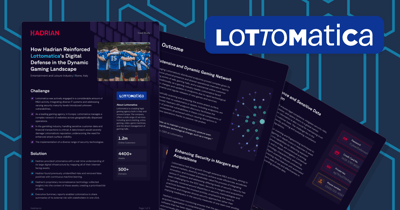Press Releases | 2 mins
Injection Attacks, DNS Vulnerabilities, and Information Leaks Among Top Cyber Risks in 2024

Amsterdam, November 12, 2024 – A recent study by Hadrian, a leader in offensive cybersecurity, reveals that the biggest cyber risks for companies in 2024 are information leaks, DNS vulnerabilities, and injection attacks. These risks are frequently found because security teams lack visibility of the complete attack surface, allowing threats to go undetected. Rogier Fischer, CEO of Hadrian, states: “Companies must be extra vigilant against these cyber risks, as a quick response can mean the difference between a minor disruption and a major data breach."
Injection attacks, DNS vulnerabilities, and information leaks
- Injection attacks: Risks such as SQL injection and cross-site scripting (XSS) account for nearly 60% of critical threats, allowing attackers to access sensitive data or insert malicious scripts.
- DNS vulnerabilities: Misconfigured DNS settings, such as incorrect CNAME records, are behind over 25% of all identified risks and are frequently exploited in phishing attacks.
- Information leaks: Over 75% of exposed secrets are classified as critical or high risk, underscoring the importance of secure handling of credentials and sensitive information.
Key challenges
One of the major challenges identified by Hadrian is the long response time and lack of collaboration between security and IT teams. Misconfigurations can take up to 73 days to resolve, while injection risks average 68 days—3 times longer than other types of threats. Fischer explains: "With trillions of intrusion attempts every year, the traditional approach of establishing perimeter and monitoring for is struggling. This decade-old defensive strategy is reactive by nature and can't keep up with the increasing volume and complexity of attacks. By adopting a hacker’s perspective with offensive security, we can proactively identify and neutralize threats before they strike."
Extent of risk for organizations
Of all detected cyber risks, 3.2% are critical threats requiring immediate action. 38.7% are classified as high risk, 19.5% as medium threats, 27.8% as low risk, and 10.8% are informational risks.
Critical cyber risks are often injection risks
Injection vulnerabilities, including SQL Injection, Cross-Site Scripting, and other injection risks, account for almost 60% of all critical cyber risks. Other critical risks include authorization and authentication (11%), file directory exposure (10%), misconfigurations (10%), exposed secrets (5%), server-side request forgery (3%), DNS issues (3%), and service exposure (2%).
DNS issues often pose high risks
DNS issues, such as dangling CNAME records and misconfigurations, account for at least 60% of high-risk cyber threats. Other high-risk issues include file directory exposure (6%), injection risks (3%), authorization and authentication (2%), cloud and SaaS configuration (1%), misconfiguration (1%), application exposure (1%), and exposed secrets (1%).
About the study
Hadrian’s report is based on an analysis of the attack surfaces of more than 300 organizations across various sectors and regions between October 1, 2023, and October 1, 2024. Active analysis was conducted to uncover vulnerabilities within cloud infrastructures, SaaS tools, and on-premise systems. Only verified risks were included to eliminate false positives, with risks assessed based on their verifiability. The severity of risks is classified using a proprietary scoring system that considers factors such as impact, detectability, and ease of exploitation.
The full report is available here
About Hadrian
Hadrian is a leading cybersecurity company specializing in offensive security. With a mission to empower organizations from a hacker’s perspective, Hadrian uses advanced technologies to identify and mitigate vulnerabilities before they can be exploited. Through continuous monitoring and proactive threat assessments, Hadrian supports companies worldwide in building resilient digital infrastructures in an increasingly complex cyber landscape.





